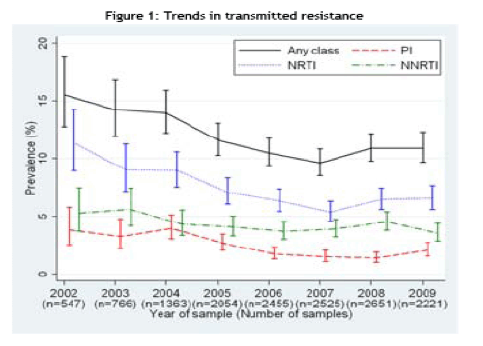 |
 |
 |
| |
Drop in Transmitted Drug Resistance May Have Stopped in UK After 2005: may be increasing except for NNRTIs
|
| |
| |
19th Conference on Retroviruses and Opportunistic Infections, March 5-8, 2012, Seattle
Mark Mascolini
Overall transmitted antiretroviral drug resistance (TDR) appeared to stop dropping in the United Kingdom after 2007, largely because of persistent transmission of thymidine analog mutations (TAMs) [1]. The findings reflect similar results from France [2].
In 2002 the UK instituted genotyping for everyone with newly diagnosed HIV. From 2002 through 2005, researchers recorded a sharp drop in TDR prevalence, which they attributed to pretreatment resistance testing, stronger and more tolerable antiretrovirals, and a growing proportion of people with viral suppression. To see if that downtrend continued after 2005, David Dolling (MRC Clinical Trials Unit, London) and colleagues at other centers planned this study.
The analysis relied on the UK HIV Drug Resistance Database, which collects data on most genotypic resistance tests done in the UK as part of routine care. Focusing on the first resistance test done between 2002 and 2009 in everyone over 16, the investigators limited the analysis to HIV-1 subtype B infections to eliminate infections probably acquired outside the UK. They defined TDR as detection of one or more mutations from the World Health Organization 2009 list for TDR surveillance.
Dowling and colleagues parsed resistance data from 14,583 antiretroviral-naive people, 79% of them men, 5% women, and the rest with unreported gender. Most people were white (70%) and most acquired HIV during sex between men (71%). Median age at resistance testing stood at 36 (interquartile range [IQR] 30 to 42), median CD4 count at 408 (IQR 271 to 560), and median days between HIV diagnosis and resistance testing at 22 (IQR 5 to 358).
Throughout the 2002-2009 study period, 11.3% of these people had detectable TDR (95% confidence interval [CI] 10.8% to 11.9%). TDR rates were 6.9% for NRTIs, 4.1% for nonnucleosides (NNRTI), and 2.2% for protease inhibitors (PIs).
The 2002-2005 TDR decline continued through 2007 (P < 0.01). After that the researchers graphed nonsignificant increases in any-class resistance (P = 0.14), NRTI resistance (P = 0.08), and PI resistance (P = 0.14). Dual-class and triple-class resistance remained stable after 2005 at 1.2% and 0.4%. The prevalence of NNRTI resistance has remained stable throughout this period.

The limited decline in NRTI resistance could be traced primarily to stable prevalence of thymidine analog mutations such as T215 revertants, K219 substitutions, and M41L. The investigators noted that those mutations usually evolve during treatment with zidovudine or stavudine (the thymidine NRTIs), and use of those drugs plummeted between 2002 and 2009--from 29.4% to 0.8% for stavudine and from 47.9% to 8.8% for zidovudine.
Dolling and colleagues concluded that TDR may have stopped falling in the UK and that "NRTI resistance in particular could be increasing." The stubborn persistence of TAMS despite steeply waning use of zidovudine and stavudine suggested to the investigators that TDR from antiretroviral-naive people may be on the rise.
The UK team recommended continued pretreatment resistance testing for all newly diagnosed people and urged renewed efforts to increase HIV testing rates.
French researchers reported overall TDR prevalence of 8.8% in 2010-2011, a rate that remained stable since the 2006-2007 survey [2].
References
1. Dolling D, Sabin C, Delpech V, et al. Has a limit to the decline in transmitted drug resistance been reached? Evidence from a large surveillance study of UK-acquired infections. 19th Conference on Retroviruses and Opportunistic Infections. March 5-8, 2012. Seattle. Abstract 732. http://www.retroconference.org/2012b/PDFs/732.pdf.
2. Descamps D, Assoumou L, Charpentier C, et al. Stable prevalence of transmitted drug resistance mutations in ARV-naive chronically HIV+ patients: France, 2006/07 to 2010/11. 19th Conference on Retroviruses and Opportunistic Infections. March 5-8, 2012. Seattle. Abstract 733.
|
| |
|
 |
 |
|
|